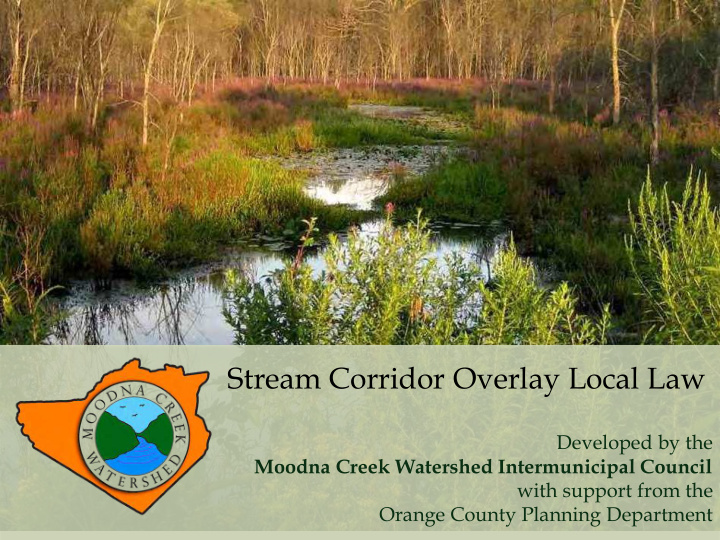



Stream Corridor Overlay Local Law Developed by the Moodna Creek Watershed Intermunicipal Council with support from the Orange County Planning Department
Why gives streams room?
Structures built too close to streams are at great risk of being damaged and/or washed downstream. Not only can this cause personal loss, but large debris can further damage downstream property and infrastructure.
Buffering Streams Saves Money Decrease flood hazards Reduce need for emergency rescues Reduce need for expensive flood mitigation projects Could decrease cost of water treatment Source: Moodna Creek Watershed Conservation and Management Plan, Appendix C
FEMA’s Community Rating System saves homeowners on their flood insurance.
Four Protection Options: A, B, C, or D A least restrictive D most restrictive Each Option has a Primary Buffer and a Secondary Buffer Source: Conservation Thresholds for Land Use Planners
Riparian Buffer Area consists of: Primary Riparian Buffer 50’ or 100’ + Secondary Riparian Buffer 50’, 100’, or 100+’ Source: Conservation Thresholds for Land Use Planners
Riparian Buffer Area Buffer Distance Range: 100’ +/- 500’ Source: Conservation Thresholds for Land Use Planners
Protection Options C & D • If a wetland or a 100-year floodplain occurs even partially within the Secondary Riparian Buffer, the entire area will be included in the Secondary Riparian Buffer. • If a steep slope or highly erodible soil occurs within the Secondary Riparian Buffer, these areas - up to a maximum of 400 feet from the stream bank - will be included in the Secondary Riparian Buffer.
Primary Riparian Buffer: Permitted Uses • Benches, seating • Approved flood control structures, GI practices, stream bank stabilization measures • Temporary erosion control measures • Maintenance of existing roads or other surfaces • Culverts • Public utilities • Recreation: non-paved trails, water-related public access • Storage of non-motorized watercraft • Limited tree-cutting, in accordance with Forest Stewardship Plan Source: Conservation Thresholds for Land Use Planners
Secondary Riparian Buffer: Permitted Uses • All uses allowed in Primary Buffer, plus • Improvements to allow passive recreation (e.g. decks, tables, playground equipment), total area not to exceed 200 sq. ft. and occupy no more than 10% of Secondary Buffer on that parcel • Fences, provided they do not impeded floodwaters • Landscaping, planting or maintenance activities that do not negatively impact integrity of Buffer Source: Conservation Thresholds for Land Use Planners
Prohibited in the Riparian Buffer : • Storage of hazardous or waste materials • Application of herbicides, fertilizers, pesticides and chemicals • Introduction of invasive species • Waste disposal, including dumping of snow, ice, manure, used automobiles or appliances, and other abandoned materials • Mining or removal of soil, sand, gravel • Stream alteration, except where permitted by NYSDEC • Parking of motorized vehicles • Alteration of rare species habitat
Protection Option A: 50’ PRIMARY Buffer
Option A: 50’ PRIMARY & 50’ SECONDARY Buffers
Protection Option D: 100’ PRIMARY Buffer
Option D: 100’ PRIMARY & 100’ SECONDARY Buffers
Recommend
More recommend